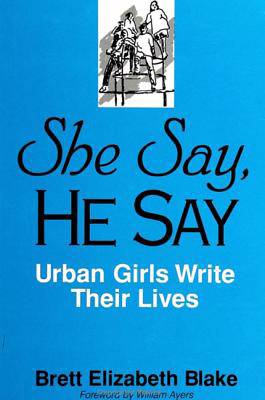
Bedankt voor het vertrouwen het afgelopen jaar! Om jou te bedanken bieden we GRATIS verzending (in België) aan op alles gedurende de hele maand januari.
- Afhalen na 1 uur in een winkel met voorraad
- Gratis thuislevering in België
- Ruim aanbod met 7 miljoen producten
Bedankt voor het vertrouwen het afgelopen jaar! Om jou te bedanken bieden we GRATIS verzending (in België) aan op alles gedurende de hele maand januari.
- Afhalen na 1 uur in een winkel met voorraad
- Gratis thuislevering in België
- Ruim aanbod met 7 miljoen producten
Zoeken
€ 145,45
+ 290 punten
Uitvoering
Omschrijving
She Say, He Say reveals the development of fifth-grade urban girls' voices through their own writing in the classroom. This book underscores the importance of including all of the girls' voices into the curriculum where their voices can be nurtured, cultured, and responded to in potentially productive ways. Through an exploration of two major writing contexts, the public and the private, Brett Elizabeth Blake chronicles how the girls learned through their writing not only how to name issues salient to them, such as domesticity and racism, but also how to resist the underlying notions of such important issues. The girls' stories are based on nearly three years of study, and the traditional notion of a process approach to writing is challenged by addressing how such an approach must become a site for significant tension and struggle over issues like ownership and voice. Blake suggests several curricular strategies, such as reader response techniques and a violence-prevention unit, as additional approaches that support girls' voices. This book explores and challenges us to look more closely at how the intersection of gender, race, and class is crucial for understanding not only how and what girls write about, but also why they write so deliberately and poignantly about their lives.
Specificaties
Betrokkenen
- Auteur(s):
- Uitgeverij:
Inhoud
- Aantal bladzijden:
- 176
- Taal:
- Engels
Eigenschappen
- Productcode (EAN):
- 9780791434796
- Verschijningsdatum:
- 11/09/1997
- Uitvoering:
- Hardcover
- Formaat:
- Genaaid
- Gewicht:
- 435 g

Alleen bij Standaard Boekhandel
+ 290 punten op je klantenkaart van Standaard Boekhandel
Beoordelingen
We publiceren alleen reviews die voldoen aan de voorwaarden voor reviews. Bekijk onze voorwaarden voor reviews.












